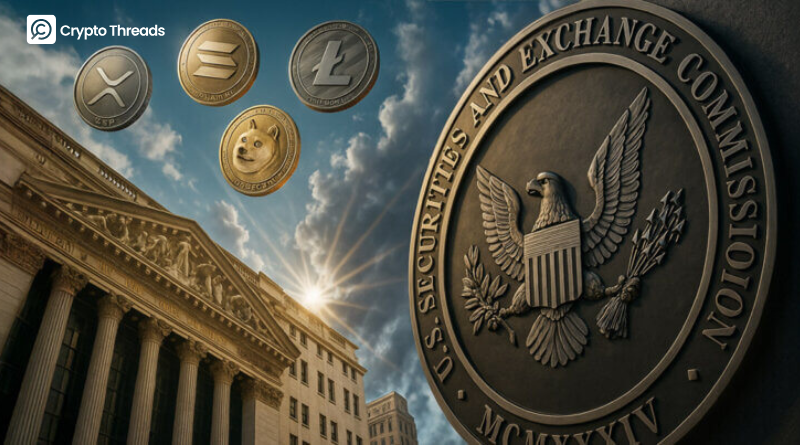SEC Fast-Tracks Crypto ETPs With New Listing Rules
Meta Description:
The SEC proposes new rules allowing crypto ETPs to be listed without individual approval—so long as tokens have six months of futures trading on Coinbase. Solana and XRP could launch by Q4 2025.
Key Takeaway:
The SEC is introducing Generic Listing Standards that would let tokens with at least six months of derivatives trading on Coinbase qualify for ETP listings, without needing individual review. This paves the way for faster approvals of products like Solana and XRP ETPs and reflects growing alignment across U.S. regulators to integrate crypto into traditional finance.
Proposal Could Accelerate Launch of Solana and XRP ETPs
On July 30, 2025, the U.S. Securities and Exchange Commission (SEC) unveiled a new proposal to streamline how crypto exchange-traded products (ETPs) are listed. Under the proposed “Generic Listing Standards,” any token that has traded for more than six months on Coinbase Derivatives would automatically qualify for ETP listing. The rule, filed by the Chicago Board Options Exchange (CBOE), aims to eliminate the need for individual product approvals and reduce friction for crypto fund issuers.
According to ETF analyst Nate Geraci, this rule could mark a turning point. If passed, fund issuers wouldn’t need to file a 19b-4 form for each new crypto product, significantly speeding up the approval timeline. Among the assets likely to benefit first are Solana and XRP. Solana’s ETP faces an October 10 deadline and would meet the new criteria this fall. XRP’s listing could follow soon after, based on its futures listing date.
The rule also includes a liquidity safeguard: if less than 85% of a product’s underlying assets are readily redeemable, issuers must implement a formal risk management framework. This requirement is meant to protect investors from redemption bottlenecks during times of volatility.
Once published in the Federal Register, the rule enters a 21-day comment period, which means it could be finalized in under two months—potentially by early Q4 2025.
Part of a Broader Shift Toward Crypto Integration in Traditional Finance
The SEC’s proposal comes shortly after the agency approved in-kind creation and redemption mechanisms for crypto ETFs, bringing them structurally closer to traditional funds. Meanwhile, NYSE Arca has filed a similar proposal, showing that the exchange industry is moving in lockstep to normalize crypto within mainstream investment vehicles.
This wave of regulatory momentum isn’t isolated to the SEC. A broader shift is underway across Washington. The White House Working Group on Digital Assets, under the Trump administration, recently published a 168-page report calling for streamlined regulatory frameworks, fewer bureaucratic delays, and support for blockchain innovation.
Legislative efforts are also gaining traction. The House has passed the GENIUS Act, which sets clearer rules for stablecoins; the CLARITY Act, which focuses on crypto market structure; and the CBDC Anti-Surveillance State Act, which aims to block any move toward a government-issued central bank digital currency. All three bills are now heading to the Senate after the August recess.
Taken together, these regulatory and legislative developments suggest a growing consensus: the U.S. is preparing to formally integrate digital assets into the traditional financial system. If the SEC’s listing rule is finalized, it could mark the beginning of a new era—where launching a crypto ETP is as routine as launching a stock or bond ETF.
Conclusion: A Defining Moment for Crypto and Capital Markets
This proposal doesn’t just simplify paperwork—it reshapes the foundation of how crypto enters public markets. By embedding crypto ETPs into the same regulatory pathways as traditional funds, the SEC is signaling that digital assets are no longer fringe—they’re infrastructure. For issuers, this reduces cost and uncertainty. For investors, it means faster access to regulated crypto exposure through familiar platforms.
As regulatory agencies align and policy frameworks mature, crypto’s transition from a volatile frontier to an integrated component of capital markets is accelerating. What happens in the next 60 days could set the tone for how digital assets are treated for the next decade.



